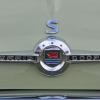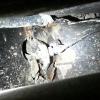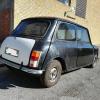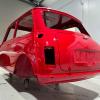Why a bolt and not an 11th stud?
Where the Bolt is fitted is just behind the Water Pump and often these go in to the cooling jacket. Because of it's location, there's little meat around and so has far less strength in the deck than all elsewhere in the deck and around the other studs. The Bolt, which only has a 5/16" UNC Thread, has a torquing up value of considerably less than the studs to prevent distortion of the block here. I think in the factory's wisdom, they fitted this bolt here of the design it is so mechanics wouldn't slip in to auto-pilot, pulling that part of the deck up through the stud hole in the head. The Torque figure of 300 in/lb (25 ft/lb) is right on the yield strength of the bolt as a 'safety valve', so that the bolt will break before any serious damage is done.
It is a popular modification to fit a stud here, matching the others in the head. That's fine as long as the overall clamping force used (and exerted in to the deck) is the same as that when the original bolt is used. Given that it's a larger diameter and on a finer thread, the torquing figure used here should be less than that that would be used on the bolt.
Personally, I don't thing the fitting of these extra 2 studs / bolts is beneficial at all. If you look at the deck of the A Series Engine, there's the 5 studs along the side (front as fitted in a Mini) and then 4 almost across the center. I can see how in design, this was arrived at, as a less (way less) than ideal arrangement, with the push rod holes to dodge around, but in engineering terms, it's far from ideal, as we have more fasteners along an edge, effectively bending the head over that way (especially given there's a soft gasket in between) and the 4 across the center working very hard, trying to pull down a far greater surface area. I feel that by adding the extra stud (and bolt to a lesser degree) only exasperates this problem, given their location closer towards the front of the deck. While the 60's Cooper S and 1300 GT engines had these from the factory, no other performance engine from the factory, including the MG Turbo, was fitted with them.
When you have a look at all head gasket failures, probably 50% are between cylinders with the other 50% being towards the 4 studs. I've never seen any towards the front.






















